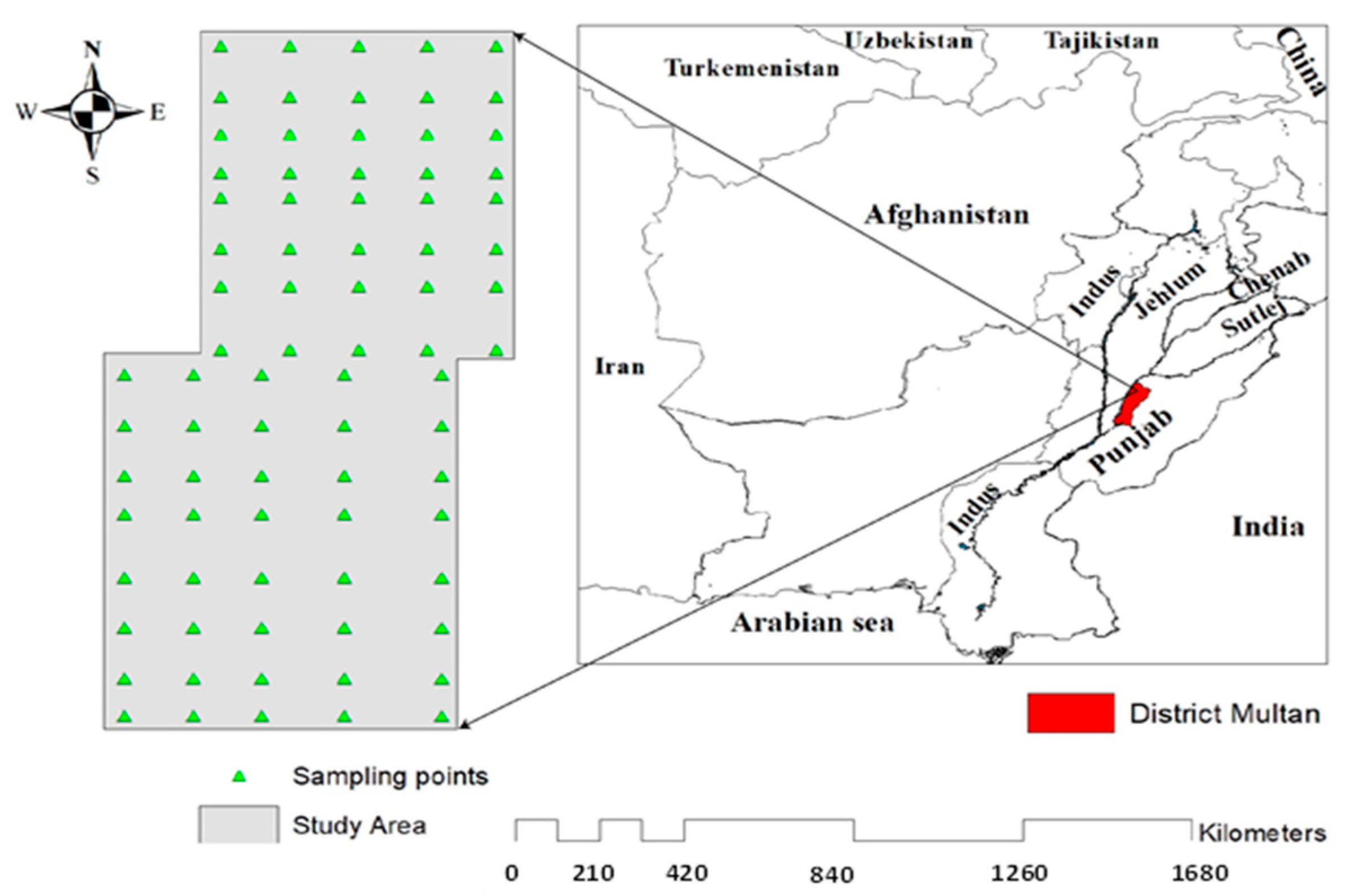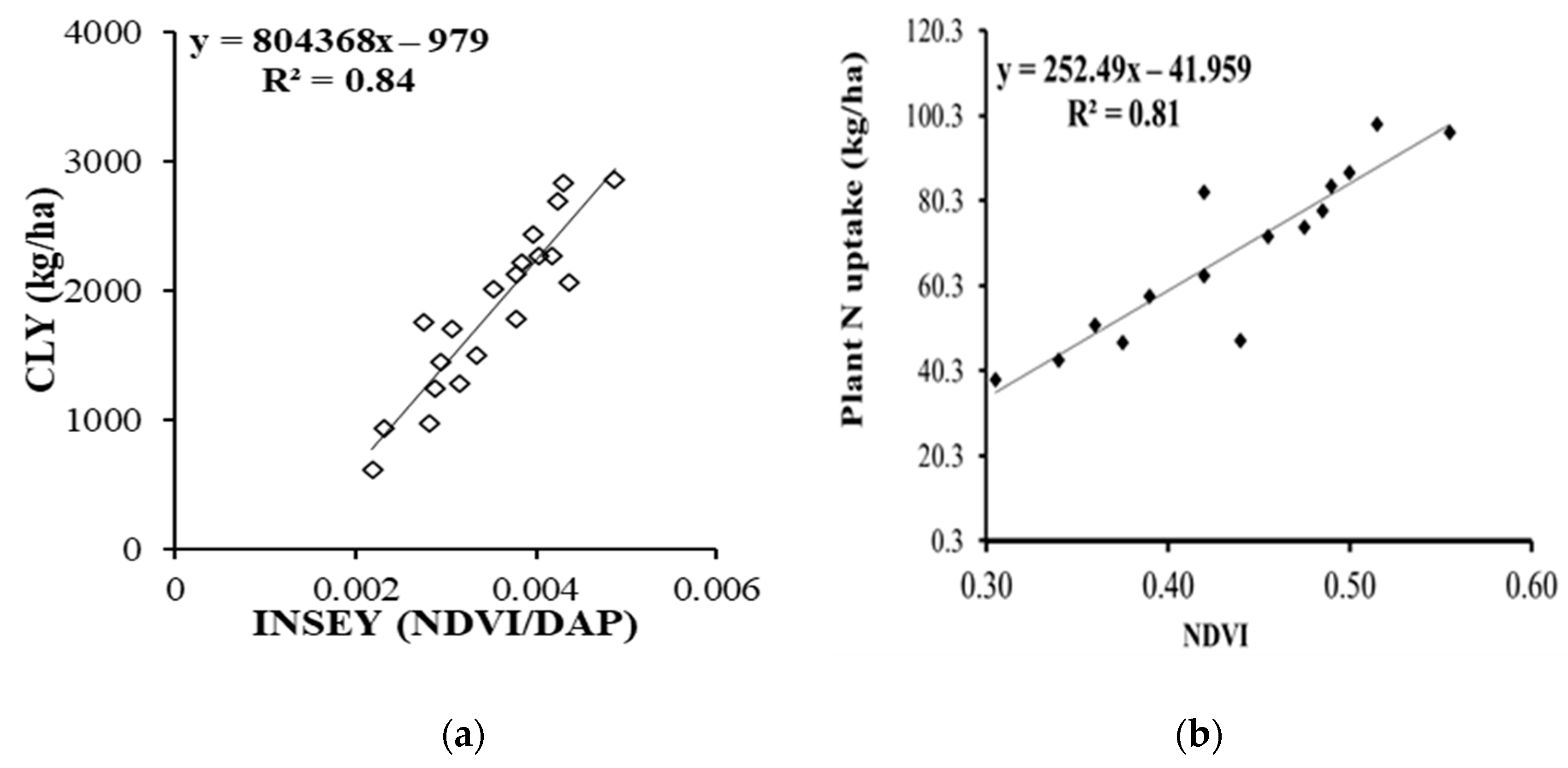Precision Nitrogen Management for Cotton Using (GreenSeeker) Handheld Crop Sensors †
Abstract
1. Introduction
2. Materials and Methods
3. Results and Discussion
GreenSeeker-Based Topdressing N recommendation Algorithm for Cotton
- Predicting cotton yield using GS INSEY (NDVI-DAP) before topdressing N fertilizer application
- ○
- Cotton lint yield CLY (kg/ha) = 804368 × (GSINSEY) − 979.
- ○
- The average N requirement (Nreq) of 0.013 kg/kg for cotton lint yield (CLY) of 2355 kg/ha was found based on the (GS) N application rate.
- ○
- Similarly, the average N requirement (Nreq) of 0.011 kg/kg for cotton lint yield (CLY) of 2335kg/ha was found based on the precision N application rate of soil analysis.
- Calculating final plant N uptake (FPNU) using predicted cotton yield and Nreq, i.e.,
- ○
- FPNU (kg N/ha) = CLY × Nreq.
- Predicting early season plant N uptake (EPNU) using GSNDVI before topdressing
- ○
- EPNU (kg N/ha) = 252.49 × GSNDVI − 41.95
- Determination of in-season topdressing N fertilizer requirement (NR)
- ○
- NR (kg N/ha) = (FPNU − EPNU)/Nitrogen use efficiency (NUE)
- ○
- NUE value was set to 40%.
4. Conclusions
Author Contributions
Funding
Institutional Review Board Statement
Informed Consent Statement
Data Availability Statement
Acknowledgments
Conflicts of Interest
References
- Kale, S.S.; Panzade, K.P.; Chavan, N.R. Modern Farming Methods: An Initiative towards Increasing the Food Modern Farming Methods: An Initiative towards Increasing the Food Productivity. Food Sci. Rep. 2020, 1, 34–36. [Google Scholar]
- Farid, H.U.; Bakhsh, A.; Ahmad, N.; Ahmad, A.; Mahmood-Khan, Z. Delineating Site-specific management zones for precision agriculture. J. Agric. Sci. 2016, 154, 273–286. [Google Scholar] [CrossRef]
- Tagarakis, A.C.; Ketterings, Q.M. Proximal sensor-based algorithm for variable rate nitrogen application in maize in northeast USA. Comput. Electron. Agric. 2018, 145, 373–378. [Google Scholar] [CrossRef]
- Cao, Q.; Miao, Y.; Li, F.; Gao, X.; Liu, B.; Lu, D.; Chen, X. Developing a new Crop Circle active canopy sensor-based precision nitrogen management strategy for winter wheat in North China Plain. Precis. Agric. 2017, 18, 2–18. [Google Scholar] [CrossRef]
- Ali, A.M.; Ibrahim, S.M.; Bijay-Singh. Wheat grain yield and nitrogen uptake prediction using atLeaf and GreenSeeker portable optical sensors at jointing growth stage. Inform. Process. Agric. 2020, 7, 375–383. [Google Scholar] [CrossRef]
- Zhou, L.; Chen, G.; Miao, Y.; Zhang, H.; Chen, Z.; Xu, L.; Guo, L. Evaluating a Crop Circle active sensor-based in-season nitrogen management algorithm in different winter wheat cropping systems. Adv. Anim. Biosci. 2017, 8, 364–367. [Google Scholar] [CrossRef]
- Yao, Y.; Miao, Y.; Huang, S.; Gao, L.; Ma, X.; Zhao, G.; Jiang, R.; Chen, X.; Zhang, F.; Yu, K.; et al. Active canopy sensor-based precision N management strategy for rice. Agron. Sustain. Dev. 2012, 32, 925–933. [Google Scholar] [CrossRef]
- Yue, S.; Meng, Q.; Zhao, R.; Ye, Y.; Zhang, F.; Cui, Z.; Chen, X. Change in nitrogen requirement with increasing grain yield for winter wheat. Agron. J. 2012, 104, 1687–1693. [Google Scholar] [CrossRef]
- Lukina, E.V.; Freeman, K.W.; Wynn, K.J.; Thomason, W.E.; Mullen, R.W.; Stone, M.L.; Solie, J.B.; Klatt, A.R.; Johnson, G.V.; Elliott, R.L.; et al. Nitrogen fertilization optimization algorithm based on in-season estimates of yield and plant nitrogen uptake. J. Plant Nutr. 2001, 24, 885–898. [Google Scholar] [CrossRef]


Publisher’s Note: MDPI stays neutral with regard to jurisdictional claims in published maps and institutional affiliations. |
© 2022 by the authors. Licensee MDPI, Basel, Switzerland. This article is an open access article distributed under the terms and conditions of the Creative Commons Attribution (CC BY) license (https://creativecommons.org/licenses/by/4.0/).
Share and Cite
Farid, H.U.; Khan, Z.M.; Anjum, M.N.; Shakoor, A.; Qureshi, H.S. Precision Nitrogen Management for Cotton Using (GreenSeeker) Handheld Crop Sensors. Environ. Sci. Proc. 2022, 23, 12. https://doi.org/10.3390/environsciproc2022023012
Farid HU, Khan ZM, Anjum MN, Shakoor A, Qureshi HS. Precision Nitrogen Management for Cotton Using (GreenSeeker) Handheld Crop Sensors. Environmental Sciences Proceedings. 2022; 23(1):12. https://doi.org/10.3390/environsciproc2022023012
Chicago/Turabian StyleFarid, Hafiz Umar, Zahid Mahmood Khan, Muhammad Naveed Anjum, Aamir Shakoor, and Huzaifa Shahzad Qureshi. 2022. "Precision Nitrogen Management for Cotton Using (GreenSeeker) Handheld Crop Sensors" Environmental Sciences Proceedings 23, no. 1: 12. https://doi.org/10.3390/environsciproc2022023012
APA StyleFarid, H. U., Khan, Z. M., Anjum, M. N., Shakoor, A., & Qureshi, H. S. (2022). Precision Nitrogen Management for Cotton Using (GreenSeeker) Handheld Crop Sensors. Environmental Sciences Proceedings, 23(1), 12. https://doi.org/10.3390/environsciproc2022023012





